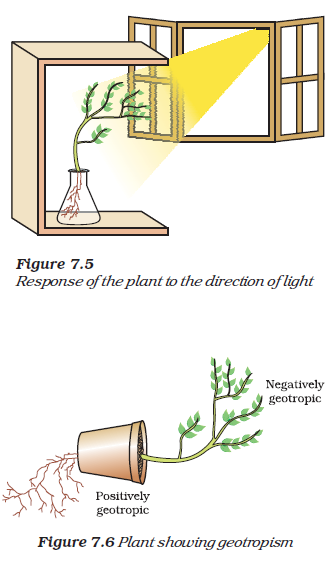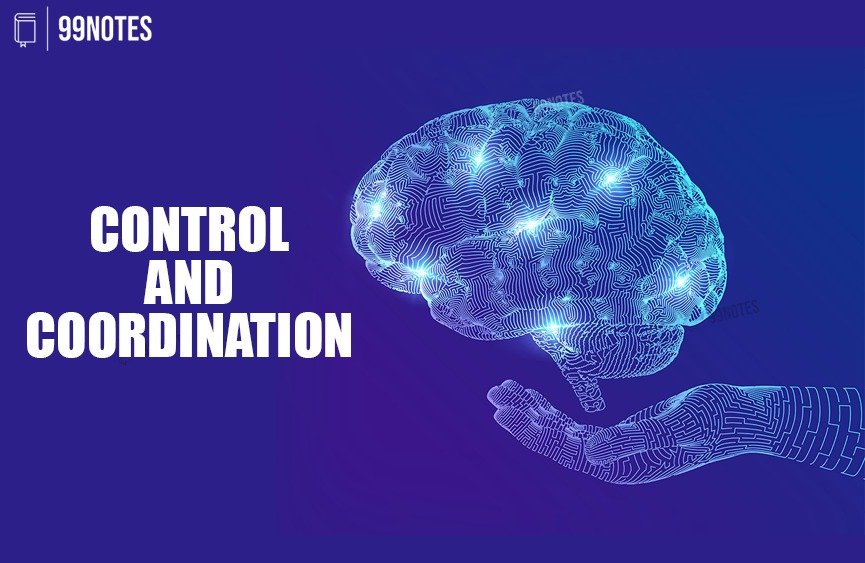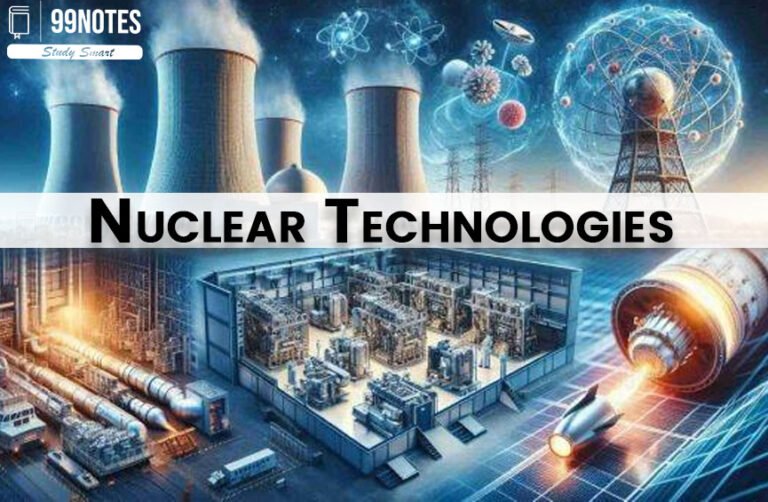Control and Coordination
What is movement?
Movement is an attempt by living organisms to use changes in their environment to their advantage. For example, Buffaloes chew cud to help break up tough food to digest it better.
Such movements have to be controlled. In multicellular organisms, specialised tissues are used to provide these control and coordination activities.
In animals, coordination is provided by the nervous and muscular tissues.
Animals – Nervous system 
In Animals, all information from the environment is detected by specialised tips of some nerve cells. These receptors are usually located in our sense organs in the greatest density the ear, nose, and tongue (olfactory receptors).
Sensation
All Information is received at the dendritic tip of a nerve cell. It sets off a chemical reaction that creates an electric impulse, that travels from the dendrite to the cell body, and then along the axon to its end.
- At the end of the axon, the electrical impulse sets off the release of some chemicals, which cross the gap (synapse) and start a similar electrical impulse in the dendrite to the next neuron.
- A similar synapse finally allows delivery of such impulse from neurons to other cells: Muscle cells or glands.
For example,
The tongue has thousands of taste buds that identify the four primary tastes – salty, sweet, sour and bitter; olfactory receptor cells in the nasal cavity measure odours that provide the sumptuous flavours in our food.
- These cells, when stimulated, send signals to specific areas of the brain, which make us conscious of the perception of taste. In this way, the messages that process taste and smell converge.
- Thinking is a complex activity, it is bound to involve a complicated interaction of many nerve impulses from many neurons.
| Neurons |
Nervous tissue is made up of an organised network of nerve cells or neurons, specialised for conducting information via electrical impulses from one part of the body to another.
|
Reflex
Reflex is the action that is performed without conscious thought as a response to a stimulus. For example, Nerves that detect heat are connected to nerves that move muscles. Making the process of stimuli and response simpler.
Reflex arc:
Nerve pathways involved in a reflex action, including at its simplest a sensory nerve and a motor nerve with a synapse between.
- This takes place at the place where the nerves fist meet in a bundle – in the spinal cord itself.
- The reflex arc has evolved because the thinking process of the brain is not fast enough. Many animals have very little or none of complex neural network needed for thinking. Thus, the reflex action must have evolved as an efficient way of functioning in the absence of a true thought process.
Human Brain:
The human brain is the coordination centre of the Human body. It is a part of the larger unit of the network of neurons known as the Central Nervous system.
Central nervous system (CNS):
The Brain and the Spinal cord form the central nervous system. It receives information from all parts of the body and integrates it.
The communication between the CNS and other parts of the body is facilitated by the peripheral nervous system consisting of:
- Cranial Nerves: These nerves arise from the brain and control functions such as vision, smell, and facial movement.
- Spinal Nerves: These nerves arise from the spinal cord and are involved in both sensory and motor functions across the body.
| Mapping of the Brain |
| The brain contains vast networks of interconnected neurons. Understanding how the brain works requires knowing how the various neurons connect to each other. A complete map of all the connections in an entire brain is called a connectome.
The Connectome has only been worked out for three organisms so far —a roundworm, a larval sea squirt, and a larval marine worm. Each of these organisms has several hundred brain neurons at most. Mapping larger and more complex brains remains a technical challenge and has been done only for parts of the brain. An international research team set out to map the entire brain of a small insect. They chose the larva of the adult fruit fly. Fruit flies show a rich mix of behaviours, yet their brains are small enough to map out within a practical time frame.
In comparison, the human brain has roughly 100 billion neurons and over 100 trillion synaptic connections. |
Parts of Brain 
The brain has three parts or regions, namely:
- The Forebrain
- The Hindbrain
- The Midbrain
The forebrain:
The forebrain forms the main Thinking part. It has regions that receive sensory impulses from various receptors.
- Separate areas of the fore-brain are specialised for hearing, smell, sight and so on.
- Different sensations are associated with different parts of the fore-brain.
- There are separate areas of association where sensory info is interpreted by putting it together with info from other receptors.
- This information is stored in the brain. We know that it is stored by changing connections between neurons or synapses. But it is still not clear how exactly this action takes place.
Motor functions through the Forebrain:
- A decision is passed to motor areas that control voluntary movement.
- Cells have special proteins that change both their shape and their arrangement in the cell in response to nervous electrical impulses.
- When this happens, new arrangements of these proteins give the muscle cells a shorter form.
The Hind brain:
The Hindbrain controls involuntary actions like breathing, walking in a straight line, riding a bicycle, and picking up a pencil. Further, reflex actions such as Watering of the mouth, digestion, breathing, and pupil size adjustment are also associated with the hind brain.
These functions are associated with the cerebellum: It is responsible for the precision of voluntary actions and maintaining the posture and balance of the body.
| How do we get to know which part of the brain is associated with which function? |
We identify which parts of the brain are associated with specific functions through various scientific methods and techniques:
|
Mid Brain:
The Midbrain plays a role in the excitation, motivation and habituation of species from humans to the most elementary animals such as insects.
Cranium:
The brain is carefully protected in a bony box called the cranium. It contains a fluid-filled balloon which provides further shock absorption.
Similarly, the Vertebral Column protects the spinal cord.
| Neuralink’s Brain-computer Interface |
| Neuralink was founded in 2016 by Elon Musk, along with a team of eight scientists and engineers.
Neuralink’s brain-computer interface (BCI) uses electrical currents to monitor and stimulate brain activity, converting neural signals into binary code for device control. The BCI aids people with paralysis to communicate and control devices. In the future, it may enhance memory, cognitive abilities, and motor, sensory, and visual functions. Clinical Trials: Neuralink is recruiting individuals with quadriplegia, particularly those with ALS or spinal cord injuries (SCI), for clinical trials involving their BCI. Animal Demos: In April 2021, Neuralink showcased a monkey playing video games by using its brain signals, demonstrating the potential of their technology. Cost: The cost of a Neuralink implant is estimated at $10,500, with insurance companies potentially being charged $40,000 for the procedure. |
Coordination in plants
Plants show 2 types of movements: 
- Dependent on growth
- Independent of growth
Movement due to growth:
Tendrils: Sensitive to touch; When they come in contact with any support, the part of the tendril in contact with the object does not grow as rapidly as the part of the tendril away from an object: It circles about objects.
Environmental triggers:
- Light: Phototropic movement: Shoots respond by bending towards light and roots respond by bending away. Hormone: Auxin.
- Heliotropism: towards sun.
- Gravity: Geotropism: Shoots – Negative geotropic; Roots- Positively geotropic. Hormone: Auxin
- Chemicals: Chemotropism: For example, the growth of pollen tubes towards ovules. Hormone: Auxin
- Water: Hydrotropism. Hormone: Abscisic acid (ABA)
Immediate response to stimulus:
When movement occurs at a place different than the point of touch. Information is communicated by electrical-chemical means to convey this information from cell to cell. [There is no specialised cell] Instead of specialised protein found in muscle cells, plant cells change shape by changing the amount of water in them: swelling & shrinking.
Limitations of Electrical impulse:
- They’ll reach only those cells that are connected by nervous tissues.
- Once an electrical impulse is generated in a cell & transmitted, the cell will take some time to reset its mechanisms before it can generate and transmit a new impulse.: Cells can’t continually create and transmit electrical impulses.
Chemical Communication
Chemical compounds (or hormones) created, diffuses all around the original cell. If other cells around have the means to detect this compound using special molecules on their surfaces:
- It is slower, but Potentially Reaches all the cells;
- It can be done steadily and persistently.
- These compounds/hormones have a great deal of diversity. Different plant hormones help to coordinate growth, development & responses to the environment.
- They are synthesised at places away from where they act & simply diffuse to the area of action.
Hormones in Plants:
- Auxin: Synthesised at the shoot tip, helps the cells to grow longer. When light is coming from one side of the plant, Auxin diffuses towards the shady side of the shoot. This concentration of Auxin stimulates the cells to grow longer on the shade-side.
- Cytokinins: Promote cell division and are present in greater concentration In areas of rapid cell division such as Fruits and seeds.
- Gibberellins: Promote the growth of stems.
- Abscisic Acid: Signals to stop growth the growth, i.e. Inhibits growth. Its effects include wilting of leaves.
Hormones in Animals:
Hormones that are part of the endocrine system form 2nd way of control and coordination.
Hormones are chemical messengers produced by endocrine glands that regulate various bodily functions, including growth, metabolism, mood, and reproduction. They travel through the bloodstream to target organs and tissues, influencing processes such as metabolism, immune response, and sexual function.
Hormones should be secreted in precise quantities. Timing and amount released are regulated by feed mechanisms.
Chemically, what are Hormones?
Hormones can be either protein-based or lipid-based (steroids) depending on their structure.
- Protein-based hormones include hormones like insulin, growth hormone, and prolactin. They are water-soluble and typically act by binding to receptors on the surface of target cells.
- Steroid hormones are derived from lipids (fats), specifically cholesterol, and include hormones like testosterone, estrogen, and cortisol. They are fat-soluble and can pass through cell membranes to bind to intracellular receptors.
Adrenaline:
Adrenaline is secreted directly into blood and carried to different parts of the body. The heart is its main target Organ/tissue; It results in the following:
- Heart beats faster: More oxygen to muscles.
- Blood to the digestive system and skin is reduced due to the contraction of muscles around small arteries in the organ, and therefore the blood is diverted to skeletal muscles.
- Breathing rate increases because of contractions of the diaphragm and rib muscles.
This makes the body ready to deal with a situation.
| Glands | Hormone | Disease Caused by Deficiency | Causes of Deficiency |
| Pancreas
(Beta cells) |
Insulin | Diabetes Mellitus (Type 1 & Type 2) | Genetic disorder (Type 1)
Insulin resistance (Type 2) |
| Thyroid gland | Thyroxine (T4) | Hypothyroidism (e.g., Hashimoto’s disease) | Iodine deficiency, Autoimmune disease (Hashimoto’s), |
| Calcitonin | Hypercalcemia (due to impaired calcium regulation) | Disorders affecting thyroid function | |
| Parathyroid glands | Parathyroid Hormone (PTH) | Hypoparathyroidism (low calcium levels, tetany) | Autoimmune disease |
| Pituitary gland | Growth Hormone (GH) | Dwarfism (if deficient in childhood) | Pituitary tumours, genetic disorders |
| Prolactin | Galactorrhea (excessive milk production) | Pituitary dysfunction, medication side effects | |
| Oxytocin | Difficulty in childbirth, Poor milk let-down | Pituitary gland damage, certain medications | |
| Vasopressin (ADH) | Diabetes Insipidus (excessive urination and thirst) | Damage to the hypothalamus/pituitary gland | |
| Follicle-stimulating hormone (FSH) | Infertility (irregular menstrual cycles in women) | Pituitary dysfunction, stress, nutritional deficiencies | |
| Luteinizing Hormone (LH) | Infertility (lack of ovulation in women, low sperm count in men) | Pituitary dysfunction, stress, nutritional deficiencies | |
| Adrenal glands (Adrenal cortex) | Cortisol | Addison’s Disease (fatigue, low blood pressure, salt craving) | Autoimmune destruction, infections, adrenal gland damage |
| Aldosterone | |||
| Adrenal glands (Adrenal medulla) | Adrenaline (Epinephrine) | No specific disease | Stress, adrenal gland dysfunction |
| Ovaries
(and placenta) |
Estrogen | Osteoporosis, Infertility | Menopause, ovarian disorders, hormonal imbalances |
| Progesterone | Infertility, Miscarriage risk | Ovarian dysfunction, stress, hormonal imbalances | |
| Testes | Testosterone | Hypogonadism (low libido, infertility) | Ageing, testicular injury, hormonal disorders |
| Pineal gland | Melatonin | Insomnia, Disrupted sleep-wake cycle | Light exposure, ageing, jet lag |
Thyroxin:
Thyroxin regulates carbohydrates, protein and fat metabolism in the body: To provide balanced growth. Its deficiency causes Goitre, which is characterised by a severely swollen neck, which is caused by Iodine deficiency.
Pituitary
The pituitary gland is often referred to as the “master gland” because it regulates the function of other endocrine glands and controls numerous vital bodily processes. Located at the base of the brain, it secretes hormones that influence growth, metabolism, reproduction, and stress responses.
- The pituitary releases hormones like growth hormone (GH) which regulates the growth and development of the body. Its deficiency leads to dwarfism.
- Thyroid-stimulating hormone (TSH), adrenocorticotropic hormone (ACTH), and prolactin, directly affect the thyroid, adrenal glands, ovaries, and testes.
- Additionally, it controls the release of hormones from the hypothalamus, playing a crucial role in maintaining homeostasis and overall body function.
Pancreas:
The pancreas produces Insulin. It helps in regulating blood sugar levels. When blood sugar level rises. It is detected by the cells of the pancreas which respond by producing Insulin.
High blood sugar rises: Causes harmful effects such as nerve damage, kidney disease, heart disease, and poor circulation, potentially leading to amputation.
Sex Hormones
Testosterone(male) and Oestrogen(female) are known as the sex hormones.
- Changes associated with puberty are controlled by the sex hormones.
- However, their production is regulated by the pituitary gland through the secretion of specific hormones.
- Estrogen regulates the menstrual cycle and ovulation. Similarly, Testosterone promotes sperm production.







